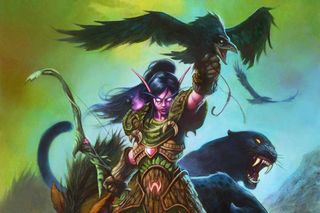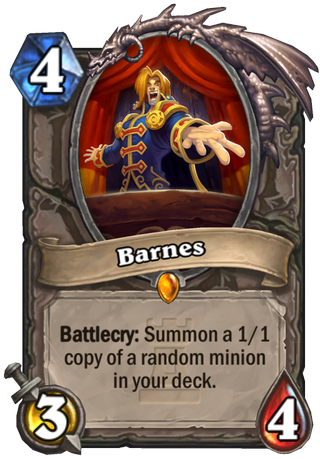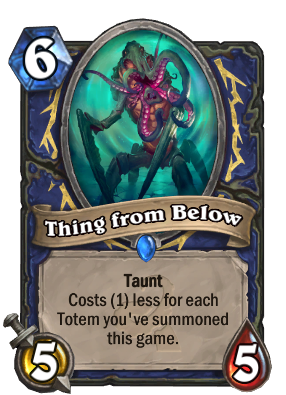How to stop evaluating Hearthstone cards wrong
Four lessons to help you sort the Doctor Booms from the Troggzors next time around.

The Hearthstone community has a less-than-perfect record when it comes to assessing the power level of new cards. When Dr. Boom was revealed, most ignored his potential impact because he died to Big Game Hunter. Mysterious Challenger was written off because Paladin secrets are individually bad, but many of us failed to consider how strong they might be when played simultaneously. When we first saw Yogg-Saron, well, we didn’t really know what to think given the insane variance, so most assumed it must be bad.
Those are some of the more spectacular examples of people getting predictions wrong, but they’re far from unusual. Many incorrect predictions are wrong in more mundane ways, simply because so few cards ever really come to define the meta. In fact, a few incorrect perceptions persist even after the cards have been released, because stubbornness results in some cards not being tested adequately.
Saltiness can also be an issue: a groundswell of opinion decreed the Karazhan expansion was bad for not changing the meta enough, but I estimate around 20 cards from it are seeing regular play, making it one of the most proportionately successful sets. With that in mind, I wanted to look back at some recent sets and focus on what it is that makes cards playable. (At least in the competitive sense, I’m not here to tell you how to have fun.)
1: “Good Enough” actually isn’t

Hello, Barnes. Aside from Menagerie Warden, I can’t think of a card that saw more hype before the release of One Night in Karazhan than Barnes. The idea that Barnes was OP rested on two premises: One, when Barnes “hits” and pulls a high-value minion from your deck, you can win on the spot. But two, even when Barnes “misses” and just pulls a vanilla 1/1, that’s good enough because it’s basically like playing Chillwind Yeti.
As it turns out, however, people don’t play Chillwind Yeti, and with good reason: in the competitive environment, a card which is “fair” is not good enough to net you a high win rate against all those other cards that do substantially more “unfair” things. To make matters worse for Barnes, his stat distribution when he misses is actually worse than a Yeti. So he’s more like a ‘roided up Razorfen Hunter, which is a card that’s seen close to no play historically.
That means the second premise is incorrect, because when you play a card which is just fair, your expected win rate dips below 50%. New players struggling with their collection will tell you as much. That means that, for every miss, Barnes needs to over-perform much more per hit to be viable.
In a few decks, that happens consistently enough for Barnes to be strong. For example, in Hunter the hit rate is quite high. Even still, Barnes doesn’t seem to be breaking the meta the way people envisioned because his downside remains significant. In most cases you’re better off playing other 4-drops that more consistently over-perform. I’ve seen many players continuing to run him in Rogue (specifically in the Malygos deck), but it strikes me as a mistake. Even when he does “hit”, the result is usually not unfair enough to make up for all the times he’s going to miss. Sure, that extra coin or card is good if you get it, but too often he will just be a bad Yeti.
The biggest gaming news, reviews and hardware deals
Keep up to date with the most important stories and the best deals, as picked by the PC Gamer team.
2: The early game always matters

There used to be a separate classification for Shaman decks not long ago: Tier Shaman. The class was considered unplayable, and for good reason. I got my golden Thrall portrait before the League of Explorers was released, and Totem Golem, Tuskarr Totemic, and Thunderbluff Valiant did not strike fear into my opponents. The class then received a single one-drop—Tunnel Trogg—and suddenly Tier Shaman took on a new meaning.
Prior to the release of Karazhan, I tried to convince people that cards like Swashburgler and Babbling Book were better than they looked. As I saw it, too many people did the following: first, they saw the body on the card and said, “Why would I play a one-mana Wisp?” After which they said: “The upside of a drawing a random card isn’t good enough.”
Both of which miss the point. The problem with a Wisp is not that the body isn’t strong. In the early game, a 1/1 body can chip away doing face damage, or be combined with a hero power ping or spell to remove an enemy minion from the board. In a tempo-based game like Hearthstone, those are very positive upsides given how much early board control matters. Games with and without that 1/1 body on board feel much different.
The real problem with Wisp is that it creates a card disadvantage because the 1/1 body costs you a card to play. Babbling Book and Swashburgler avoid that shortcoming by effectively refunding you the card. What you receive will be random, so it won’t always be spectacular, but it’s still gas in the tank and very seldom is the card completely useless. Sometimes it’s even quite good—I’ve rebuilt my gameplan around a card that popped out of one of them on the first turn. They also place you at an informational advantage, since your opponent can’t play around all the possibilities.
Unlike Wisp, the usefulness of these cards also isn’t restricted to the early game. Babbling Books and Swashburglers can be slotted into later turns to use up spare mana, activate combos, and give you extra pings from your Flamewaker. Most Mages realized this early, and every Tempo list is now running two copies of Babbling Book. Rogue players have been slower on the uptake, opting to play clunkier cards like Barnes and Deadly Poison, but they’ve also been coming around with time.
Finally, let’s not forget the big one: Spirit Claws. This was something of a sleeper in the set (I certainly missed it), but its value quickly shined because of the weapon’s ability to both dominate the early game, provide face damage in the late game, and remedy a key weakness of the class: the inability to deal with low-health, single targets efficiently.
When assessing new cards, always remember that the early game matters a lot, but any card that’s good in the early game and retains value into later turns is definitely one to keep an eye on.
3: Don’t overvalue conditional effects

I mentioned Menagerie Warden earlier, which people genuinely feared would catapult Beast Druid to the top of the meta overnight. But as things stand, the card looks close to being the Troggzor of the Karazhan set in that it’s had almost no serious impact despite all that early hype. The reason for that is because Menagerie Warden’s Battlecry depends on the board state.
Players soon realized that all they needed to do was keep the Druid board clear of beasts going into turn six, which wasn’t terribly difficult owing to the average quality of the Beasts. We can also see that Menagerie Warden’s effect is pretty slow, unlike the similarly conditional Houndmaster. You don’t get value from the Warden’s copied minion immediately unless it has Charge.
Medivh’s Valet was another card people had high hopes for which ended up whiffing. It has seen some play, but is by no means feared or common. Returning to our first lesson, a vanilla 2/3 is not good enough. Which means the Valet only gets enough value when it goes off, and it doesn’t do that consistently enough.
In order for a conditional card to be good enough, its condition needs to be easily met, the effect needs to be strong, or it needs to be solid when played independently of its condition. Malchezaar’s Imp, for instance, has a good statline for a one-cost minion, can be activated easily by cards you would be playing otherwise, and has a powerful effect when it pays off. Houndmaster has a poor statline, but can usually be activated because of Hunter's plentiful sticky beasts and has a powerful effect when it hits.
By contrast, the three damage from Medivh’s Valet if your deck runs secrets and you have one in play isn’t a consistent enough punch. The effect is too conditional, in the sense that it relies on you playing cards you otherwise wouldn’t include.
4: Understand the danger of Mana reduction effects

This is a lesson we should have learned from vanilla Hearthstone: Innervate is one of Druid’s best cards. Preparation is core to Rogue. Sorcerer’s Apprentice is too dangerous to leave alive. Also, Black Lotus is good. Who knew?
During the Patron Warrior era, I argued that the real problem card wasn’t Warsong Commander, Frothing Berserker, or Grim Patron—it was Emperor Thaurissan. In general, decks like Handlock and Control Warrior could counter Patron pretty well… except when Patron got to have turns that should have cost 16 mana or more. It was when these impossible turns happened that you got a board full of charging Patrons and Frothings breaking through taunts thanks to three free whirlwind effects and two free Executes.
The lesson was repeated with Whispers of the Old Gods. It turns out paying 0-Mana for a Thing from Below is pretty good. When almost every card in the Shaman deck leads to a future tempo advantage, and even your hero power helps create power turns, it’s little wonder that Shaman has become dominant. The nerfs to Tuskarr Totem and Rockbiter have slowed the class down a little, but by no means defanged it, and free Thing From Belows are a big part of that.
With Karazhan’s release, we were taught the importance of free cards again. Arcane Giant and Cloaked Huntress both turned out to be very strong. Importantly, they don’t just cheat a little mana or provide you with sub-optimal bodies for their benefits. Both cards can potentially cheat a lot of mana, and are fairly easy to activate for what should be impossible tempo swings.
The cards that haven’t seen play that cheat mana have always been the ones that are more tricky to activate: Knight of the Wild has to be in your hand (Thing from Below does not), Shadowfiend has to live a turn (Emperor does not), Volcanic Drake’s cost reductions are temporary (Arcane Giant’s are not). Whenever you see a card that can cheat mana, the less conditional the effect the more you should be wary of it.
Most Popular


